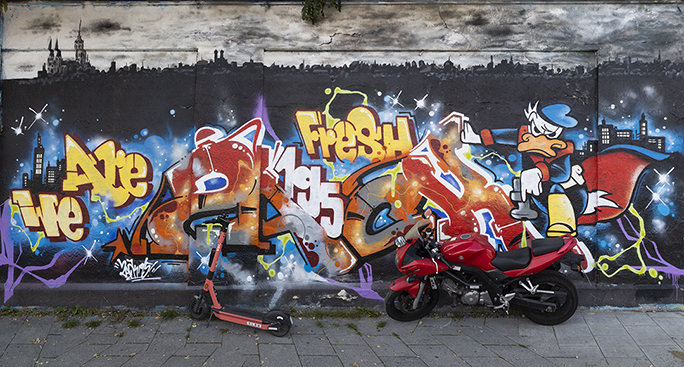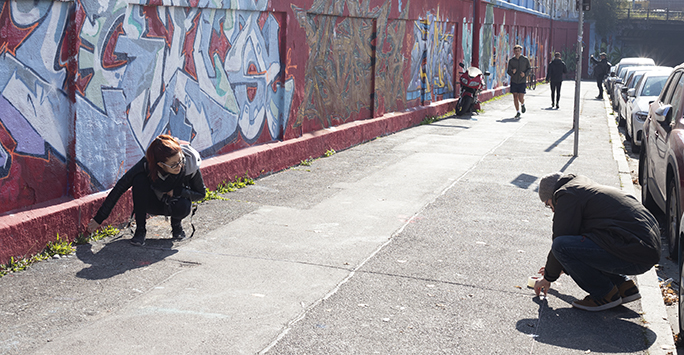
Four years ago I was teaching in Munich, and during that time I photographed a number of pieces of street art on Tumblingerstraße in the city. You can read that story and its associated comments here.
The photos were taken in the urban landscape, on a street with cars parked along the curb, making it impossible to step back far enough to take photos of the works in one frame. Also, single photos are not high enough in resolution for my projects. I need hundreds of megabytes in order to print on wide-format ink-jet printers or large pages on offset presses.

I like the way the real motorcycle and scooter blend into the mural as if painted there.
In response to this need for high resolution, I used a technique I call repositioned panoramas where the subject is photographed as a series of images taken horizontally at fixed intervals, then stitched together in Adobe Photoshop using its Photomerge function.
I have used this technique to scan strips of historic photographic film, creating multi-gigabyte images. The technique works really well.
In the field, it’s slightly more challenging to shoot “panoramic” images if you move the tripod between shots. In fact, if you are shooting anything with visible perspective, it makes images that are impossible to stitch.
My street art photos pose very little perspective trouble because they are painted on walls, and those walls have almost no relief, therefore not much chance of perspective shifts. In 2017 I used a technique where I took a shot, then took three careful steps to the right, then took another shot, and continued until I had a stepped record of the scene.
It worked well, and the images I made were excellent. They exhibited some small flaws, but I attribute these to my handling of the camera with no tripod.

The works are fluid, and are often replaced by new works put up by other artists.
I am back in Munich now, teaching at Hochschule München, and on my second weekend here I ventured back to Tumblingerstraße to see how it has changed. All of the artwork is new – it is constantly refreshed with new art – and the location has expanded considerably. Now there is an entire village on Tumblingerstraße dedicated to street art and related art. There are buildings inside the wall with more art, there is a café, and it appears that people live and work in the village (I’m still learning about the village).
My students tell me that there is an occasional concert there, and on Sunday last week there was a flea market there, open to the public. People were lined up to buy fleas.
To make my repositioned panoramic images better I knew I had to be more accurate in taking the source photos, and for that I needed a team of photographic helpers.
As part of the course I am teaching, I have the students documenting Tumblingerstraße, interviewing the artists, and taking a large number of photos. These will become part of a book we are writing and producing as part of the class. One team worked on taking new repositioned panoramic images of the artwork.
Our new technique relies on using a tripod, using a higher-resolution camera, and taping a long piece of string to the sidewalk, marked with increments for the camera (we tied knots in the string every meter). We set up the camera, put it on manual focus and manual exposure, then locked the camera facing the artwork. We then hung a plum-bob from the center column of the tripod, and moved the tripod and its centering tool from one knot to the next for the photos.

The string was taped to the ground at three meters’ distance from the wall, so the subject-to-camera distance was constant. This meant that we were photographing the artworks with much more precision than I had when I first did this. We took two photos in each position – just in case – and we moved a total of 130 meters along the wall to capture all of the images.

This step was critical to getting the shots to be consistent.
The images on this wall are not level, nor is the wall. It goes downhill, and so do the images on it. We set the camera parallel to the base of the wall to photograph each image as straight to the wall, regardless of the slope of the wall. As a result, the slope is removed from the images.
By eliminating almost all opportunity for error, we made the exposures and then processed them through Adobe Bridge to convert them to DNG* as we downloaded them from the camera card. Then we selected a series representing one piece of work and opened them in Adobe Photoshop.
From there, we chose Automate from Photoshop’s File menu, then Photomerge. In Photomerge, we selected the open images, chose Reposition as the technique for the merge, and let Photoshop do its work. Running on a new MacBook Air with the M1 processor, each combined image too about one minute to process. The resulting images are about 250 MB each, and show no significant errors of stitching.
These will make excellent photos for inclusion in our book, which we plan to print with long, wide pages to accommodate the wide stitched panoramic images we made at Tumblingerstraße.
*You can read my essay about converting Raw files to DNG here.
